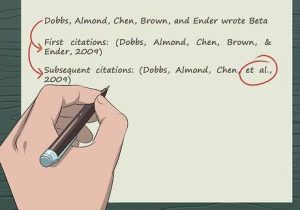Referencing in academic writing refers to the practice of acknowledging the sources of information and ideas used in your work. This is an essential aspect of academic writing as it helps in maintaining the credibility and originality of the work. Proper referencing ensures that the work is free from plagiarism and gives credit to the original authors of the information used. This article provides a comprehensive guide to referencing styles in academic writing, including clear explanations and examples for each style. Whether you are a student, researcher, or professional, understanding and correctly using referencing styles is essential for maintaining academic integrity and ensuring the credibility of your work. This guide will help you understand the different referencing styles and how to apply them effectively in your writing.
How to Using Different Referencing Styles
There are several referencing styles used in academic writing, such as APA, MLA, Harvard, etc. The referencing style used depends on the academic discipline involved. Under this section, we will explain three types of referencing styles, their in-text citations, reference lists, along with different examples.
1. APA (American Psychological Association): APA is a citation style commonly used in social sciences and other related fields. It provides guidelines on how to format and reference sources in academic writing. We will cover some of the basics of APA style referencing.
In-Text Citations: APA style requires in-text citations to give credit to the sources used in writing the paper. These citations should match the corresponding reference list entry and should include the author’s last name and the publication year. For in-text citations, you can use either the author-date system or a signal phrase. Examples:
According to Smith (2010), positive thinking has the power to change one’s life.
The effects of meditation on mental health have been extensively studied (Brown, 2015).
If there are multiple authors, only the first author’s name is used, followed by “et al.” For example: (Smith et al., 2010). If the source has no author, the citation should include the first few words of the title and the year of publication: (“Title of the Source,” 2021). It is important to note that APA style requires strict adherence to formatting guidelines, including margins, spacing, font, and headings.
Reference List: APA style requires a reference list at the end of the paper, which provides full details of all sources cited in the text. The reference list should be ordered alphabetically by the first author’s last name. The following are the basic formats for different types of sources in APA style with examples:
Books: Author, A. A. (Year). Title of work: Capital letter also for subtitle. Publisher. Example:
Smith, J. (2010). The power of positive thinking. Random House.
Journal articles: Author, A. A. (Year). Title of article. Title of Journal, volume number (issue number), page range. Example:
Brown, S. (2015). The effects of meditation on mental health. Journal of Mental Health, 24(5), 267-275.
Webpages: Author, A. A. (Year, Month Day of Publication). Title of webpage. Website name. URL. Example:
Gates, B. (2021, January 12). The future of technology. Microsoft.com. https://www.microsoft.com/en-us/future-of-technology/
Conference Proceedings: Author, A. A. (Year, Month of Publication). Title of presentation. In Conference Name (pp. page range). Location.
2. MLA (Modern Language Association): MLA style is a citation style used primarily in the humanities, particularly in English and foreign language writing. The style was established by the Modern Language Association in order to provide a standardized method for scholars to document their sources and present their research. The latest edition of the MLA Handbook for Writers of Research Papers was published in 2016, and it outlines the basic guidelines for MLA style citation. MLA style citations consist of two parts: in-text citations and a works cited page (Reference List).
In-Text Citations: In-text citations are brief references in the text of a paper that indicate the sources of information used. In-text citations in MLA style include the author’s last name and the page number(s) where the information was found, and they are usually inserted in parentheses at the end of the sentence that uses the source. For example: (Smith 23). If the author’s name is mentioned in the sentence, only the page number is included in the citation. For example: According to Smith, “The study showed that…” (23). If a source has no known author, the title of the work is used instead.
Works Cited (Reference List): The works cited page is a comprehensive list of all sources used in the text, and it appears at the end of the paper. Additionally, it is formatted in alphabetical order by the author’s last name. It should be at the end of your document and list all of the sources you have cited in your paper. It should be titled “Works Cited” and be in alphabetical order by the author’s last name. Here is an example of how a book citation should look in MLA style:
Austen, Jane. “Pride and Prejudice.” Penguin Classics, 1813.
For an article from a database, the citation should look like this:
Smith, John. “The Importance of MLA Style.” Journal of Academic Writing, vol. 34, no. 2, 2020, pp. 123-139. JSTOR, doi: 10.123/jaw34.2.123.
For a website, the citation should include the author’s name (if available), the title of the web page, the name of the website, the publication date (if available), and the URL or DOI:
Johnson, Mary. “The History of MLA Style.” The Writing Center, 22 May 2020, writingcenter.edu/history-of-mla-style.
If a source has no known author, it is listed by the first word of the title (excluding “A”, “An”, and “The”). The format for each source listed on the works cited page depends on the type of source, such as a book, journal article, or website. It’s important to note that the format of MLA citations may change based on the type of source being referenced. For more information and specific guidelines, the MLA Handbook (8th edition) should be consulted.
3. Harvard: Harvard referencing style is a popular citation style used in academic writing, particularly in the field of humanities and social sciences. This referencing style is widely used in Harvard University and other institutions. The Harvard style of referencing is a parenthetical author-date citation system, which provides a concise and clear method of acknowledging the sources used in your work.
In-Text Citations: In Harvard style, the author’s name is included in the text, followed by the publication date and page number in parentheses. For example: (Smith, 2018, p.23). If the author’s name is included in the text, only the publication date and page number need to be included in the parenthesis. For example: According to Smith (2018), …
Reference List: The reference list is a complete list of all the sources cited in your work, and it is usually placed at the end of your assignment. The reference list is an alphabetical list of all the sources, and it is arranged in the following format:
Author’s Surname, Initials (Year of Publication). Title of the book or article. Place of Publication: Publisher.
For example:
Smith, J. (2018). Harvard Referencing Made Easy. New York: ABC Publishers.
Electronic Sources: For electronic sources, it is essential to include the date you accessed the source, the URL or DOI, and the date of publication if available. For example:
Smith, J. (2018). Harvard Referencing Made Easy. [Online]. Available at: https://www.abc.com/harvardreferencing [Accessed: 20th February 2018].
Conclusion
Referencing is a crucial aspect of academic writing, and there are several widely used referencing styles to choose from. By familiarizing yourself with the rules and conventions of each style, you can ensure that your citations and references are correctly formatted, helping to establish credibility and prevent plagiarism in your work. Proper referencing shows that the writer has done the research thoroughly and has taken the time to acknowledge the sources used in the creation of the work.




